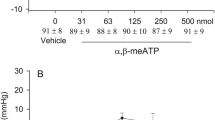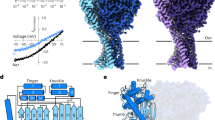Abstract
Opiates1,2 and α-agonists3,4 bind to separate and structurally specific sites on neurones in the central1,3 and enteric nervous systems2,4. One functional consequence of this binding is inhibition of cell firing5,6, which may be due to hyperpolarization of the resting membrane by opiates, such as has been observed in the guinea pig locus coeruleus7 and myenteric plexus8, and by clonidine in the myenteric plexus9. However, the discharge frequency of many nerve cells is limited by the membrane hyperpolarization which follows a period of activity, and which is caused by a transient increase in the intracellular calcium concentration leading to the activation of a membrane potassium conductance10. Neurones of the guinea pig myenteric plexus exhibit such a calcium-dependent potassium conductance11–13. We now report that both opiates and clonidine prolong this calcium-dependent after-hyperpolarization at concentrations (100 pM–10 nM) which are considerably lower than those usually required to hyperpolarize the resting membrane. Such a prolongation of the after-hyperpolarization will limit the frequency of discharge of neurones without altering their resting potential. The nature of the effects of morphine and clonidine are of interest in view of the similarities between the anatomical distribution of binding sites for these two drugs and the close parallels between their pharmacological effects in animals and man.
This is a preview of subscription content, access via your institution
Access options
Subscribe to this journal
Receive 51 print issues and online access
$199.00 per year
only $3.90 per issue
Buy this article
- Purchase on Springer Link
- Instant access to full article PDF
Prices may be subject to local taxes which are calculated during checkout
Similar content being viewed by others
References
Pert, C. B. & Snyder, S. H. Science 179, 1011–1013 (1973).
Leslie, F. M., Chavkin, C. & Cox, B. M. J. Pharmac. exp. Ther. 214, 395–402 (1980).
U'Prichard, D. C. & Snyder, S. H. J. biol. Chem. 252, 6450–6463 (1977).
Tanaka, T. & Starke, K. Naunyn-Schmiedebergs Archs Pharmak. 309, 207–215 (1979).
North, R. A. Life Sci. 24, 1527–1546 (1979).
Aghajanian, G. K. Nature 276, 186–188 (1978).
Pepper, C. M. & Henderson, G. Science 209, 394–396 (1980).
North, R. A. & Tonini, M. Br. J. Pharmac. 61, 541–549 (1977).
Morita, K. & North, R. A. Br. J. Pharmac. 74, 419–428 (1981).
Meech, R. W. A. Rev. Biophys. Bioengng. 7, 1–18 (1978).
North, R. A. Br. J. Pharmac. 49, 708–711 (1973).
Nishi, S. & North, R. A. J. Physiol., Lond. 231, 471–491 (1973).
Hirst, G. D. S., Holman, M. E. & Spence, I. J. Physiol., Lond. 236, 303–326 (1974).
Nicholson, C., ten Bruggencate, G., Stockle, H. & Steinberg, R. J. Neurophysiol. 41, 1026–1039 (1978).
Guerrero-Munoz, F., Cerrata, K. V., Guerrero, M. L. & Way, E. L. J. Pharmac. exp. Ther. 209, 132–136 (1978).
Gold, M. S., Redmond, D. E. & Kleber, H. D. Lancer ii, 599–602 (1978).
Author information
Authors and Affiliations
Rights and permissions
About this article
Cite this article
Tokimasa, T., Morita, K. & North, A. Opiates and clonidine prolong calcium-dependent after-hyperpolarizations. Nature 294, 162–163 (1981). https://doi.org/10.1038/294162a0
Received:
Accepted:
Issue Date:
DOI: https://doi.org/10.1038/294162a0
This article is cited by
-
Molecular Physiology of Enteric Opioid Receptors
The American Journal of Gastroenterology Supplements (2014)
-
Presynaptic effects of scopolamine, oxotremorine, noradrenaline and morphine on [3H] acetylcholine release from the myenteric plexus at different stimulation frequencies and calcium concentrations
Naunyn-Schmiedeberg's Archives of Pharmacology (1987)
Comments
By submitting a comment you agree to abide by our Terms and Community Guidelines. If you find something abusive or that does not comply with our terms or guidelines please flag it as inappropriate.



